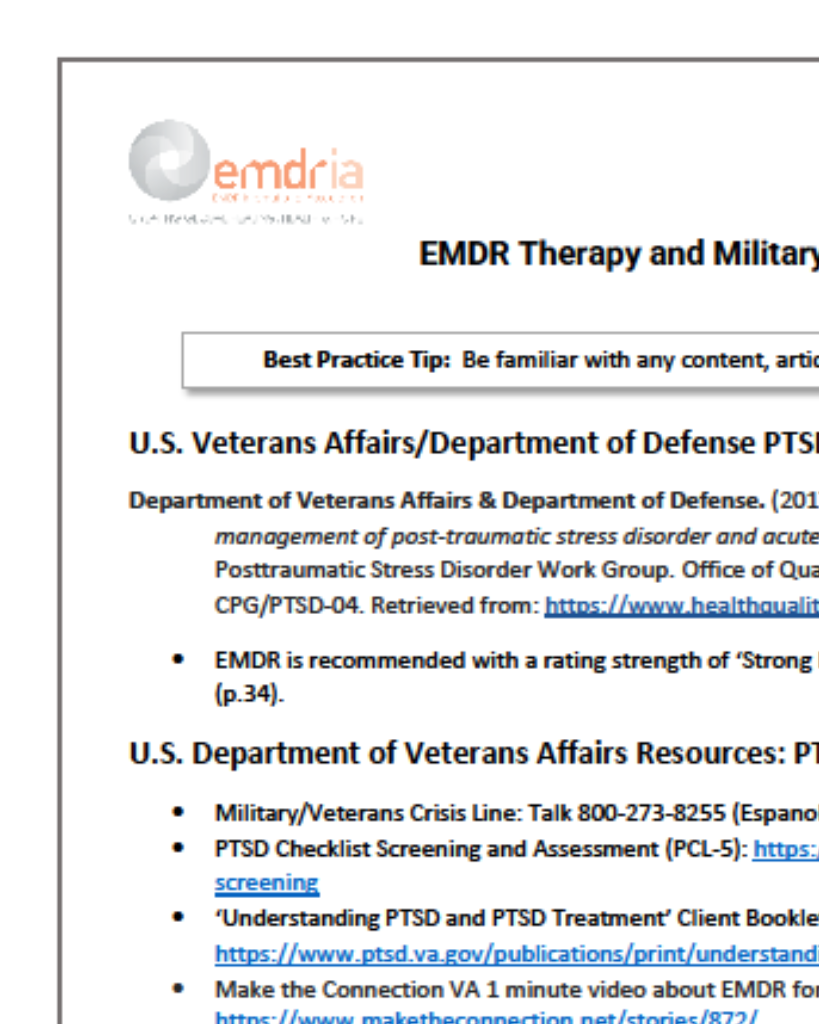Errors in the 2017 APA Clinical Practice Guideline for the treatment of PTSD: What the data actually says
This review looks at methodological issues and omissions in the 2017 APA Clinical Practice Guideline for PTSD that resulted in the undervaluing of EMDR therapy in those guidelines.
Article Abstract
“The American Psychological Association (APA) Practice Guidelines for the Treatment of Posttraumatic Stress Disorder (PTSD) concluded that there was strong evidence for cognitive behavioral therapy (CBT), cognitive processing therapy (CPT), cognitive therapy (CT), and exposure therapy yet weak evidence for eye movement desensitization and reprocessing (EMDR). This is despite the findings from an associated systematic review which concluded that EMDR leads to loss of PTSD diagnosis and symptom reduction. Depression symptoms were also found to improve more with EMDR than control conditions. In that review, EMDR was marked down on strength of evidence (SOE) for symptom reduction for PTSD. However, there were several problems with the conclusions of that review. Firstly, in assessing the evidence in one of the studies, the reviewers chose an incorrect measure that skewed the data. We recalculated a meta-analysis with a more appropriate measure and found the SOE improved. The resulting effect size for EMDR on PTSD symptom reduction compared to a control condition was large for studies that meet the APA inclusion criteria (SMD = 1.28) and the heterogeneity was low (I2 = 43%). Secondly, even if the original measure was chosen, we highlight inconsistencies with the way SOE was assessed for EMDR, CT, and CPT. Thirdly, we highlight two papers that were omitted from the analysis. One of these was omitted without any apparent reason. It found EMDR superior to a placebo control. The other study was published in 2015 and should have been part of APA guidelines since they were published in 2017. The inclusion of either study would have resulted in an improvement in SOE. Including both studies results in standard mean difference and confidence intervals that were better for EMDR than for CPT or CT. Therefore, the SOE should have been rated as moderate and EMDR assessed as at least equivalent to these CBT approaches in the APA guidelines. This would bring the APA guidelines in line with other recent practice guidelines from other countries. Less critical but also important, were several inaccuracies in assessing the risk of bias and the failure to consider studies supporting strong gains of EMDR at follow-up.”
—Description from publisher
Article Access
Open Access
Dominguez, S. K., & Lee, C. W. (2017). Errors in the 2017 APA Clinical Practice Guideline for the treatment of PTSD: What the data actually says. Frontiers in Psychology, 8, 1425. Open Access: https://doi.org/10.3389/fpsyg.2017.01425
Date
August 21, 2017
Creator(s)
Sarah K. Dominguez. Christopher W. Lee
Topics
PTSD
Extent
7 pages
Publisher
Frontiers
Rights
Copyright © 2017 Dominguez and Lee. This is an open-access article distributed under the terms of the Creative Commons Attribution License (CC BY). The use, distribution or reproduction in other forums is permitted, provided the original author(s) or licensor are credited and that the original publication in this journal is cited, in accordance with accepted academic practice. No use, distribution or reproduction is permitted which does not comply with these terms.
APA Citation
Dominguez, S. K., & Lee, C. W. (2017). Errors in the 2017 APA Clinical Practice Guideline for the treatment of PTSD: What the data actually says. Frontiers in Psychology, 8, 1425. Open Access: https://doi.org/10.3389/fpsyg.2017.01425
Audience
EMDR Therapists, Other Mental Health Professionals
Language
English
Content Type
Article, Peer-Reviewed
Access Type
External Resource, Open Access




